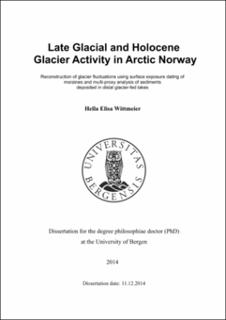| dc.contributor.author | Wittmeier, Hella Elisa | |
| dc.date.accessioned | 2021-05-10T07:53:07Z | |
| dc.date.available | 2021-05-10T07:53:07Z | |
| dc.date.issued | 2014-12-11 | |
| dc.identifier.isbn | 978-82-308-2759-8 | |
| dc.identifier.uri | https://hdl.handle.net/11250/2754504 | |
| dc.description.abstract | Late Glacial and Holocene glacier activity in Arctic Norway was reconstructed based on high-sensitivity 10Be dating of a moraine sequence deposited by the mountain glacier Rødhetta on the island of Arnøya, and a study of sediments deposited in several distal glacier-fed lakes located down the valley from the northern outlet of the Langfjordjøkelen ice cap on the Bergfjord Peninsula.
In Paper I, we present the first comprehensive Late Glacial through Holocene 10Be dated mountain glacier moraine chronology in Arctic Norway. We show that temperature-sensitive mountain glaciers in Arctic Norway reached their maximum Late Glacial extent about 1000 years prior to the onset of the Younger Dryas. Following considerable retreat, glaciers re-stabilized about 12.3 ka ago, showing oscillatory retreat through the rest of the Younger Dryas stadial with the final culmination about 11.5 ka ago. The Younger Dryas glacier advances were significantly smaller in amplitude than the earlier Late Glacial culmination. No subsequent culminations took place during the Holocene until the Little Ice Age. The presented chronology of the Arctic mountain glacier is complemented by the glacier modeling results. The Equilibrium Line Altitude (ELA) lowerings compared to present day related to each moraine are as follows: Late Glacial ~220 m, Younger Dryas ~130 m, and Little Ice Age ~80 m. The most likely climate conditions during the moraine formation periods are represented by summer temperature cooling compared to present-day by ~3.2 °C during the Late Glacial culmination, by ~1.9 °C during the Younger Dryas, and by ~0.8 °C during the Little Ice Age. We show that this pattern is consistent with updated glacier records in the North Atlantic region, with suggested peak Late Glacial ice during the Bølling-Allerød/Antarctic Cold Reversal interval, a considerably smaller culmination early in the Younger Dryas stadial, and slight glacier retreat throughout the Younger Dryas. To explain this Late Glacial pattern and its similarity to southern mid-latitude glacier records, we propose that the Late Glacial bipolar seesaw mechanism was primarily a (northern) winter phenomenon, while summer temperatures were synchronized between the hemispheres by atmospheric CO2 forcing, as documented by the interhemispherically consistent Late Glacial mountain glacier records.
In Paper II, we present a high-resolution relative glacier activity record covering the past ~10,000 cal. a BP from the northern outlet of the Langfjordjøkelen ice cap in Arctic Norway, reconstructed from detailed geomorphic mapping, multi-proxy analyses of distal glacier-fed lake sediments, and sedimentary fingerprinting. Principal Component Analysis was used to characterize sediments of glacial origin and trace them in a chain of lakes located down the valley. Of the variations in the sediment record of the uppermost Lake Jøkelvatnet, 73% can be explained by the first Principal Component axis and tied directly to upstream glacier erosion, while the glacial signal becomes weaker in the more distal lakes Store Rundvatnet and Storvatnet. Magnetic susceptibility and titanium count rates were found to be the most suitable indicators of Holocene glacier activity in the distal glacier-fed lakes. The complete deglaciation of the valley of Sør-Tverrfjorddalen occurred ~10,000 cal. a BP, followed by a reduced or absent glacier during the Holocene Thermal Optimum. The Langfjordjøkelen ice cap reformed with the onset of the Neoglacial ~4100 cal. a BP, and a gradually increasing glacier activity culminated during the Little Ice Age in the early 20th century. Over the past 2000 cal. a BP, periods of decreased glacier activity were centered around 1880, 1600, 1250 and 950 cal. a BP, while intervals of increased glacier activity occurred around 1680, 1090, 440 and 25 cal. a BP. The reconstructed Holocene glacier activity at the Langfjordjøkelen ice cap is consistent with regional temperature proxy records and glacier variability reconstructions across Norway. Long-term changes in the extent of the northern outlet of the Langfjordjøkelen ice cap largely followed trends in regional summer temperature, while winter season atmospheric variability may have triggered multidecadal glacier fluctuations and generally affected the amplitude of glacier events. | en_US |
| dc.language.iso | eng | en_US |
| dc.publisher | The University of Bergen | en_US |
| dc.relation.haspart | Paper I: Wittmeier, H.E., Schaefer, J.M., Bakke, J., Rupper, S., Paasche, Ø., Schwartz, R. and Finkel, R.C. (2020): Late Glacial Mountain Glacier culmination in Arctic Norway 14,000 years ago consistent to southern mid-latitudes. Published as: Late Glacial mountain glacier culmination in Arctic Norway prior to the Younger Dryas. Quaternary Science Reviews, 245:106461. The article is available at: <a href=" https://hdl.handle.net/11250/2754479" target="blank">https://hdl.handle.net/11250/2754479</a> | en_US |
| dc.relation.haspart | Paper II: Wittmeier, H.E., Bakke, J., Vasskog, K. and Trachsel, M. (2015): Holocene glacier activity in Arctic Norway reconstructed using multi-proxy fingerprinting in distal glacier-fed lake sediments. Published as: Reconstructing Holocene glacier activity at Langfjordjøkelen, Arctic Norway, using multi-proxy fingerprinting of distal glacier-fed lake sediments. Quaternary Science Reviews, 114:78-99. The article is not available in BORA due to publisher restrictions. The published version is available at: <a href=" https://doi.org/10.1016/j.quascirev.2015.02.007" target="blank">https://doi.org/10.1016/j.quascirev.2015.02.007</a> | en_US |
| dc.title | Late Glacial and Holocene Glacier Activity in Arctic Norway. Reconstruction of glacier fluctuations using surface exposure dating of moraines and multi-proxy analysis of sediments deposited in distal glacier-fed lakes | en_US |
| dc.type | Doctoral thesis | en_US |
| dc.rights.holder | Copyright the author. All rights reserved. | en_US |
| dc.identifier.cristin | 1199193 | |
